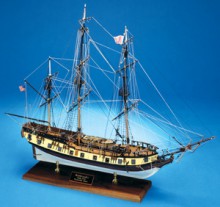 Loading... Please wait...
Loading... Please wait...Categories
Our Newsletter
- Home
- Wooden Kits
- Privateer Rattlesnake 1780 Massachusetts by Model Shipways
Privateer Rattlesnake 1780 Massachusetts by Model Shipways
Product Description
Brief History
It was supposedly in 1781 that Rattlesnake was built as a privateer at Plymouth, Massachusetts for a Salem syndicate; John Andrews, and others. The Preble Papers in the Massachusetts Historical Society indicate that the designer and builder was John Peck of Boston. She was first commissioned on June 12, 1781 with Master Mark Clark at the helm. This, however, is early in the year. Consequently, there is some question about the actual building date. The ship could have been under construction in 1780 or earlier.
During 1781, at a time when privateering was losing its luster, British frigates still lay off the coasts of noteworthy American colonial towns, keeping tabs on shipbuilding departures, and raiding shipping centers. It was along these routes that Rattlesnake met her fate when she was captured by British 44-gun H.M.S. Assurance.
Rattlesnake was sent to England where she was taken into the Royal Navy and renamed Cormorant. Her hull lines were taken at the Plymouth Dockyard in 1782. In 1783, when the Admiralty found out they already had a ship named Cormorant, the ship was again named Rattlesnake. In 1784 or 1786, she was sold out of Naval service. Beyond that her history is not clear. One source says she was used by the French as a privateer and named Le Tonnant, but this is not confirmed by any authority.
Despite her moderate size, Rattlesnake was shiprigged and Impressive in appearance and feature beyond her broadside strength.
The ship was 89' 3" long on deck, with a molded beam of 22', a mean draft of 8' 1-1/2", and 198-70/94th tons burthen. Her molded displacement was 221.3 long tons. Along with 85 men, she carried twenty 6-pounders only, a psychological ploy no doubt, but her lines reveal a fast and weatherly ship.
Kit History
The Model Shipways Hull and Rigging plans for Rattlesnake were prepared in 1963 by Mr. George F. Campbell, who passed away several years ago. Mr. Campbell was a noted British marine artist, author, naval architect, and historian. He was a member of the Royal Institution of Naval Architects. One of his most noteworthy publications is China Tea Clippers. He also developed the drawings for the Cutty Sark restoration in England and authored Model Shipways' model handbook, Neophyte Shipmodeler's Jackstay.
The Model Shipways plans prepared by Mr. Campbell are based on Admiralty draughts and a reconstruction originally published by Howard I. Chapelle in his book,The History of American Sailing Ships, and also The Search for Speed Under Sail. The rigging and deck equipment is based on contemporary texts.
The Model Shipways kit of Rattlesnake initially offered a solid hull model. This kit has now been converted to a Plank-On-Bulkhead type hull. The P-O-B hull plans were prepared in 1994 by Ben Lankford along with this complete new instruction manual.
Kit Description
The Wooden kits by Model Shipways offer well detailed, high quality ship models that are easy and fun to build. The Double Plank-On-Bulkhead Wood Hull Constructions are perfectly shaped to begin assembly. The complete kits includes Wood materials, Brass turnings, and Cordage ETC. plus instruction and plans.
Source: Extracts from Ship Model Kits and Fittings Catalog publication 1980, Model Shipways® is a registered trademark of Model Shipways, Inc., Bogota, N.J. 07603
Warranty Information
Other Details
Customers Who Viewed This Product Also Viewed
-
$4.46$4.00
-
$49.99$18.88
-
$44.98$32.98
-
$134.00$82.88










![Programming Active Server Pages [Paperback]](http://www.ultra-digital.com/storeii/shoppingcart/product_images/l/954/Prog-Active-Serv-P1010116A-R1__16046_thumb.jpg)



